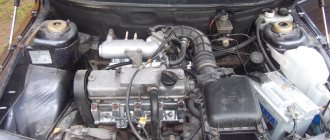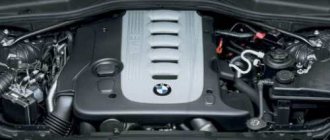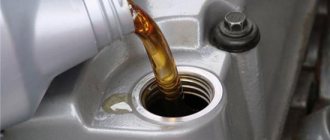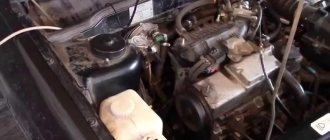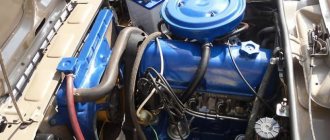An internal combustion engine is a kind of furnace in which, during the combustion of working mixtures, the temperature in the cylinders reaches 2000 °C and higher. At such temperatures, the metal begins to lose its strength characteristics, which can lead to problems associated with the operation of the engine, or, in general, send it to the cemetery. To avoid such consequences, cars are equipped with a cooling system that limits the temperature limits of the engine, thereby ensuring the correct conditions for its operation. A car engine is a metal mechanism, which, unfortunately, is not perfect. And various types of failures in its operation are still present. The most famous are when the engine gets very hot, or, conversely, takes a long time to warm up. What causes this?
Why is it necessary to warm up the engine?
Warming up the engine began in the last century, when the vehicle was moved after the engine had reached the desired temperature. Warming up occurs at idle speed. Before moving, you need to wait a few minutes so that the motor does not stop along the way. All parts warm up and function normally. Warming up is necessary to ensure normal engine operation, narrowing the gaps between parts, maintaining the required viscosity of the engine oil and reducing fuel consumption.
How to change oil correctly
Place the car on a flat surface so that the lubricant level in the power unit can be correctly determined.
Start the engine for 3-5 minutes so that it liquefies a little.
Drain the waste through the hole in the crankcase into a previously prepared container.
Change the oil filter to a new one, which matches the number with the parts catalogue;
Pour 3.4-3.6 liters of new lubricant into the neck.
The power unit is started for 3-5 minutes, so that the lubricant disperses through the channels of the lubrication system. Check the level again and, if necessary, top up to the required level.
Checking the functionality of the thermostat
The design of the device implies sensitivity to changes in temperature. The pressure in the coolant system does not affect the restriction of antifreeze circulation through the small circuit, cylinder head and block cooling space. As the temperature difference between the engine and the environment increases, the thermostat gradually opens the coolant supply from the main radiator to the engine.
The same thing happens when the difference in indicators decreases. This process helps maintain and limit the temperature limit of the engine, as well as heat the interior of the car. To determine if the thermostat is working properly, you do not need to remove it.
You can detect a breakdown manually when starting the engine. When it has warmed up for 5 minutes, you can check the device.
Starting will cause coolant to circulate through the engine's cooling passages. Heating of the coolant begins in the engine and radiator of the car. The pipe going in the opposite direction from the radiator to the engine should not be hot. If this happens, then there is a problem with the thermostat.
What can be done?
If the car is not warming up well, you can inspect the thermostat yourself.
Removing the air tube
The main reasons for poor heating in winter include air lock. It is useful for a car driver to have the knowledge and skills to remove air from the system. Its accumulation occurs at the highest point - the throttle assembly. From there you need to remove the air plug. The sequence of actions is as follows:
- Unscrew the filling cap on the engine, remove the screen and screw the cap into place to avoid contamination of the crankcase.
- Find 2 pipes, which are located side by side in the throttle assembly, and pull out 1 of them.
- Open the coolant expansion tank and cover it with a clean cloth.
- Blow slowly into the tank until antifreeze flows out of the hose.
- Put the tube back on and tighten the clamp quickly so that no air gets into the pipe.
This scheme is suitable for the VAZ 2114. When clogging of the cooling paths occurs frequently, check the entire system, which may be depressurized. If after these steps the engine temperature does not rise, then you need to look for another source of problems.
Engine insulation
By insulating the engine, you cannot get rid of all problems with warming up. If the engine is properly insulated, it will not require prolonged warming up during the day, and the coolant temperature will be normal. To insulate domestic equipment, heat-insulating material is installed between the radiator and the front grille. The motorist can use cardboard or buy special insulation.
In a purchased product, the padding consists of synthetic insulation covered with a leather substitute. It has the advantage of special holes that open when the temperature rises. Insulation can be achieved by installing a heat insulator under the hood. Special blankets have been developed for this purpose.
You can buy them or make them yourself from felt, mineral wool or other material. This type of thermal insulation helps prevent a layer of ice from freezing on the hood, which often happens in winter when snow falls on the car, melts and freezes. The heat insulator can be glued to the lower engine protection. In the future, it will need to be cleaned of dirt so that it does not get into the engine.
Principle of operation
Coolant enters the radiator through the thermostat. This is a large circle of fluid circulation. The thermostat usually opens at a temperature of 100 degrees Celsius. If the temperature has not reached this limit, then the liquid moves in a small circle. A thermostat malfunction is manifested by improper opening of the valves.
When the thermostat is closed, the engine overheats, and a constantly open one leads to low temperatures, since the liquid will only flow in a large circle.
Due to irregular changes of antifreeze or antifreeze, use of running water or mixing of coolants, various deposits in the form of scale may accumulate in the system. In this case, the thermostat will inevitably jam in one of its positions.
Radiator clogged
The radiator can be clogged from the outside and inside. External contamination is associated with dust and other debris, as well as insects, entering the honeycombs. This worsens heat transfer and is manifested by frequent operation of the fan and a long operating time.
Clogged engine radiator honeycomb
A good high pressure washer solves the problem. If the radiator has been in use for a long time, the car cools and heats up worse due to deformation of the honeycombs. You can “cure” this problem by replacing the radiator.
The radiator rarely clogs from the inside. This usually occurs due to poor quality antifreeze, driving on water, or as a “side effect” of radiator sealants. The presence of this problem is indicated by the coolant: it becomes cloudy, oil stains and solid particles are visible in it. Flushing the cooling system of the VAZ 2114 is carried out by completely draining the antifreeze with distilled water with the addition of radiator cleaning agents.
According to statistics, three-quarters of the answers to the question why the engine of the “four” heats up are associated with one of the malfunctions listed above. You can diagnose and eliminate them yourself without involving the services of a car service. If none of the above methods solves the problem, it is better to contact a specialist for diagnosis.
Causes of the problem and consequences
There are many sources of the problem. The engine takes a long time to warm up in the following cases:
- presence of ice or air lock in the cooling system;
- poor quality antifreeze or incorrectly selected product;
- thermostat failure;
- problems with temperature sensors;
- poor quality oil or incorrectly selected lubricant.
Failure to properly warm up the car can lead to negative consequences, including:
- Possibility of costly repairs. Wear can lead to motor seizure or other damage.
- Problems with the cooling system. The devices it consists of can operate under normal conditions. Changes in temperature can negatively affect the functioning of sensors, thermostats and other parts.
- Reduced engine power level. Engine efficiency decreases with increasing flow rate and element load.
- Wear of motor components. At constant low temperatures there is a risk of breakdown and the need for major repairs.
- Increased fuel consumption.
Warming up the power plant must be carried out regularly and for a long time, otherwise the car will not work normally.
What are the consequences of poor engine warm-up before driving?
Many will say, so what if the engine doesn’t heat up to the required temperatures? After all, the car drives, and sometimes not worse than at operating temperatures. The issue of warming up is incredibly important for the normal operation of the car, and there are many explanations for this. It is not for nothing that the manufacturer sets the operating temperature range of the unit with an accuracy of a degree; this is an important indicator for the long service life of the motor and the preservation of its characteristics. These are the problems you can get with incomplete warming up:
Special climatic conditions in the Russian Federation force us to pay special attention to the operation of the car. Otherwise, within a few years after purchasing a new car, you will have a pile of scrap metal, destroyed by domestic climatic conditions. And the issue of warming up the power plant is one of the most serious in terms of the duration and quality of operation of one of the most expensive components in a car.
The engine does not warm up to operating temperature: consequences
On the dashboard of modern cars, a special scale is provided to monitor engine temperature. The driver can observe at what temperature the motor operates, from which to draw appropriate conclusions. If, during prolonged operation of the engine, its temperature does not reach the optimal 85-90 degrees, it is necessary to understand the causes of the malfunction as soon as possible.
Operating a car with a supercooled engine will not lead to anything good. The following problems can be identified that await the driver if the engine does not warm up to operating temperature and operates in this mode for a long time:
- Increased fuel consumption. The fact is that the electronic control unit is responsible for the amount of fuel injected in modern cars. If the engine does not reach operating temperature, the ECU recognizes it as cold and issues a command to inject a rich mixture;
- Increased carbon deposits on engine components (in particular, spark plugs) and an increased risk of coking;
- Reduced engine power characteristics due to engine operation not in optimal mode;
- Low efficiency of lubricating components, which leads to increased friction and increased wear.
Constant operation of the engine in a non-optimal temperature state can quickly damage it and lead to the need for major repairs.
Does the engine take a long time to warm up? When should you be nervous?
It is quite possible that the engine takes a long time to warm up due to the fact that the car has such design features. For a VAZ 2107, for example, it will be difficult to move away in cold weather if the car does not run in warm-up mode for up to 5 minutes. The same story applies to old VAZ 2114 engines and many other representatives of this manufacturer. You need to worry about the condition of the car if there are such features:
- Previously, the engine warmed up much faster, but now to start normal operation you have to stand for long minutes and listen to the uneven revolutions of the unit and the dead temperature needle;
- when warming up, unprecedented symptoms began to appear - the speed fluctuates too much, the voltage in the on-board network drops, the car stalls or other anomalies occur;
- when you start driving, you feel a significant lack of power, the engine tries to pull out under load, it seems that you are dragging a heavy trailer behind you;
- when starting, you have to turn the starter for too long, warming up occurs at low speeds, the engine constantly works as if under a heavy load, and the consumption is simply enormous;
- The engine does not reach operating temperatures even after several hours of operation; this also indicates problems that should be eliminated for a normal trip.
Of course, you should not compare the summer heating mode and winter operating options, since the seasonal behavior of the machine can change greatly. But in case of such problems, along with prolonged warming up of the engine, it is worth contacting a service station. The problem is that many such troubles can have a negative effect on the operation of the car, reduce its efficiency and shorten the potential service life of many parts of the unit.
What can be dangerous about a cold engine?
If you notice that the engine has not warmed up to operating temperature and it cannot rise, then you should start immediately troubleshooting, as the consequences can lead to serious expenses for repairs.
The electronic control unit installed on modern cars recognizes an unheated engine as a cold one. If it cannot warm up and the engine temperature does not rise, then an over-enriched mixture is supplied.
When the system has to operate in this mode, the spark plugs fail due to the appearance of carbon deposits on them and on the internal elements. Thus, you can significantly reduce the service life and face major repairs, which cost a lot of money.
If the engine does not warm up to operating temperature, you should immediately contact a car service to diagnose the problem so that similar malfunctions do not occur in the future.
Effect of motor oil
As you know, engine performance depends on the quality of the oil. The degree of heating of the engine will depend on this, especially in winter. Depending on what kind of oil is used (synthetic or semi-synthetic), the engine may heat up differently, and the range of fluctuations in coolant temperature will be from 5 to 20 degrees.
Depending on how liquid the motor lubricant is, how well and quickly the engine will start in winter, as well as the degree to which it heats up quickly. Therefore, it is recommended to fill only high-quality oil into the engine before winter.
What poppies can be grown on the plot?
But what should you do if you really want to recreate a clearing on your property with poppies, cornflowers, daisies and other meadow herbs? Take heart, because the genus Papaver has more than 100 species, and only a few are prohibited. You can choose from annual and perennial poppies.
Annual self-seeded poppy fits well into natural-style plantings
The most famous representative of the first group is considered to be the poppy (P. rhoeas). It fits perfectly into natural-style plantings. This annual blooms profusely from June until autumn. Less common are the stunningly beautiful annual modified poppy (P. commutatum) and peacock poppy (P. pavoninum).
Among the perennials, it is worth highlighting the bare-stemmed poppy (P. nudicaule), which blooms from May until late autumn. Depending on the variety, its flowers are double and simple, white, yellow and orange, with a diameter of 2.5-6 cm (in the compact variety 'Popsale' they are as much as 10 cm in diameter). So, as we see, there are plenty of legal poppies.
You can find seeds of a wide variety of varieties on sale, take a look at our market (section Papaver seeds) and choose yours!
https://agronomu.com/bok/5862-opiynyy-snotvornyy-mak.htmlhttps://www.ogorod.ru/ru/main/useful/15128/Mak-pod-zapretom-ili-net.htmhttps:// nasrf.ru/baza-znaniy/tipy-narkomanii/mak-snotvornyyhttps://7dach.ru/MoySad/maki-v-sadu-opasnaya-krasota-25206.html
Other reasons
A malfunctioning thermostat may not be the only reason why the engine does not reach operating temperature.
If the pipes were not tightened well during the previous repair, the car owner is faced with air leaks. Coolant begins to leak. If this is the problem, then you should tighten the clamps for a tighter fit of the tubes and add fluid to the required level in the expansion tank.
In this case, the car owner will see a low temperature on the dashboard, which is insufficient for operation. In fact, the engine will overheat and may even boil.
During the winter season, engine performance is also affected by the use of other systems. So, using a cabin heater can lead to the engine not heating up well, since the stove takes some of the heat onto itself. In this case, you will see how the arrow of the engine temperature indicator drops.
A faulty temperature sensor can cause the engine to feel like it takes a long time to warm up or may not heat up at all. In this case, the engine works properly. The sensor transmits temperature status data to the dashboard. If it does not work correctly, then the readings will be incorrect. Replacing this part will bring all indicators back to normal.
The problem with the sensor is quite serious on modern cars equipped with electronics. Here again you will have to deal with supplying an over-enriched mixture and replacing many other parts.
Last tip
If you still look for the reason for what is happening to your engine - no, because of reluctance or lack of ability - look for smart specialists! There is no point in going to dealerships. The specialists who work there will not help you due to the fact that they are not trained in more than maintenance and pre-sale preparation.
As you know, there are constant disputes among car enthusiasts regarding warming up the engine before driving, the operating temperature of the internal combustion engine and the speed at which it reaches the required heating. However, most motorists continue to warm up their engine every morning. Accordingly, from time to time with some regularity the question arises about why the engine takes a long time to warm up.
Read in this article
The engine temperature arrow does not rise, the engine temperature fluctuates, the engine cools down while driving
The time it takes for the engine to warm up to operating temperature may vary for each serviceable unit. This happens due to the fact that heating and its intensity depend on a number of conditions. The warm-up speed can be affected by the degree of engine boost, its type (gasoline/diesel), the general condition of the cooling system, the quality of the antifreeze or antifreeze poured in, the outside temperature, the degree of load while driving, the intensity of the heater in the cabin, and so on.
Let us add that many experts agree that different types of motor oils and their viscosity can also affect the overall heating of the engine, although only slightly. The operating temperature of the oil in a conventional engine is around 100-150 degrees, not exceeding the maximum threshold of about 200 degrees (all indicators are averaged). In parallel with this, the maximum oil temperature in the engine is determined by the flash point of the oil, its coking, etc.
It may seem that the temperature range will be the same for different oils, but this is not the case. Special additive packages that reduce friction losses and the base itself (synthetic, semi-synthetic) affect the degree of oil heating. In other words, low-viscosity oils cool rubbing couples better, but the lubricant itself heats up more. It turns out that with different engine oils, the temperature in the crankcase of the same internal combustion engine can differ by 5-7 degrees. If we take into account these features, then we can assume that with “liquid” synthetics, the engine will not only be easier to start in winter, but will also warm up faster.
So, let's return to the cooling system. A cold engine and a non-working heater in most cases are the consequences of thermostat malfunctions. If you notice that the power unit takes a very long time to heat up, the engine does not warm up to operating temperature, and the engine temperature gauge needle drops while driving, then you should start checking with this device.
The thermostat allows heated coolant to enter the radiator. This circulation through the radiator is called a large circle. The thermostat opens strictly at a certain temperature on different internal combustion engines (on average about 90 degrees Celsius), that is, up to the specified value, the liquid circulates only in a small circle. Problems begin when the thermostat stops opening or closing in a timely manner. If it does not open, then the engine overheats. If the thermostat is open all the time, the antifreeze will constantly circulate only in a large circle, and the engine will not warm up to operating temperature.
The thermostat jamming, both open and closed, occurs due to the accumulation of scale and other deposits in the cooling system. The reason is irregular changes of antifreeze or antifreeze every 3 or 4 years, mixing coolants with each other, using running water in the cooling system, ignoring the need to flush the system.
We also recommend reading the article on how to flush the cooling system yourself at home. From this article you will learn about various methods and means for flushing the engine cooling system with your own hands.
To check the thermostat, start the cold engine and let the unit idle for 5-10 minutes. Then you should feel with your hand the upper and lower hoses going to the radiator. If the thermostat is in good condition, then the pipes should not be heated. In other words, the coolant does not enter the large cooling system circuit until the liquid warms up to a temperature that is the opening temperature of the thermostat on a particular engine. In practice, this looks like this: the temperature arrow on the dashboard should rise, warm or even hot air should come out of the air deflectors, but the radiator pipes remain cold. Once the pointer reaches operating temperature, the thermostat should open. After this, the hot liquid will flow through the pipes in a large circle into the radiator, heating the indicated elements. It turns out that if the radiator and pipes immediately warm up after starting a cold engine, then the thermostat does not close the large circle, that is, its malfunction is obvious.
It is more difficult to determine a breakdown when the device opens or closes, but not completely. In such a situation, there may be partial overheating or insufficient heating of the motor. There are also cases when the thermostat does not jam constantly, but only periodically. In any case, the element must be removed, defective, repaired or completely replaced. On different engines, the location of the thermostat may differ. On some motors, access to the element can be very difficult. Usually the device is located in the place where the upper radiator hose approaches the engine. Less common are designs where the installation location is the area where the lower hose is supplied.
The air in the cabin does not heat up for a long time, what is the reason?
Another big problem with warming up a car for a long time in winter is that it takes too long for the air in the cabin to warm up. You have to drive with terribly cold air from the air deflectors, scrape ice off the glass in the cabin and encounter various other troubles. Therefore, solving this problem is often a priority. It is worth paying attention to several possible reasons for this unpleasant effect:
- general problems with warming up the engine, which we discussed above, because if the fluid is not warmed up, then cold air will enter the cabin, this is an inevitable consequence;
- blockage in the cooling system - there may be air pockets in the stove itself, which do not in any way affect the quality of operation of the rest of the system; they can be eliminated at service stations;
- problems in the heater radiator - often the radiator itself is the cause of problems, it can be clogged, dirty inside or outside, which causes the effect of cold air in the cabin;
- clogged air ducts - often the problem of foggy glass and cold in the cabin is connected, it is worth cleaning the air ducts and inspecting them by removing the front panel and other parts in the cabin;
- broken switches and regulators - often car owners come to service stations who do not suspect that the temperature in the cabin is cold due to a non-functioning temperature control knob.
These are the unusual reasons that can occur when the interior is poorly heated. As a rule, such problems also include fogging and icing of the windows in the cabin, terrible stale air during a long trip, unpleasant odors, high humidity and even dampness. Such effects will clearly not benefit your car, nor will they provide a pleasant experience when using the vehicle. So you should get rid of them as soon as possible.
Watch a video on how to check the thermostat's operation:
Let's sum it up
In this article, we examined one of the most common reasons why the engine does not warm up, may cool down while driving, the engine temperature does not rise above 70 degrees, etc. Let us add that in the latter case, on a car with an unknown history, it often turns out that the previous owner had previously installed a too “cold” thermostat. In parallel with this, other malfunctions of the cooling system may occur, as a result of which the internal combustion engine does not heat up.
It should also be noted that repairing the device is impractical given its relatively low cost. For this reason, instead of descaling the thermostat and trying to eliminate its jamming, it is better to immediately install a new element on the machine.
Sources
- https://autochainik.ru/dvigatel-ne-progrevaetsya.html
- https://avtodvigateli.com/neispravnosti/ne-progrevaetsya.html
- https://okeydrive.ru/pochemu-dvigatel-ne-progrevaetsya-do-rabochej-temperatury/
- https://KrutiMotor.ru/dvigatel-ne-nagrevaetsya/
- https://www.avtovzglyad.ru/sovety/ekspluataciya/2020-09-30-chto-delat-esli-dvigatel-perestal-progrevatsja-do-rabochih-temperatur/
[collapse]
Which system is responsible for maintaining a constant engine temperature?
No vehicle is insured against breakdowns. Car components and assemblies consist of many small components, the functional life of which has significant limitations. If a car owner notices that the temperature of the internal combustion engine is dropping while driving, he needs to pay close attention to the integrity of the cooling system elements. This is where the causes of the problems lie.
The essence of the cooling system is the movement of a special liquid - antifreeze through two technological circles. One of them is small and does not provide for the passage of coolant through the cooling radiator located in the front part of the engine compartment. It is limited to circulation only along the “shirt”.
The passage of a large contour begins to occur when driving over medium and long distances. A special thermostatic valve is responsible for switching circles, opening the path for coolant into the radiator when it gets too hot. There the antifreeze cools down and returns to the system already cold.
